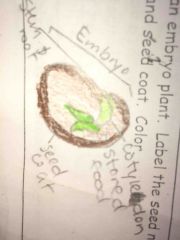![]()
![]()
![]()
Use LEFT and RIGHT arrow keys to navigate between flashcards;
Use UP and DOWN arrow keys to flip the card;
H to show hint;
A reads text to speech;
34 Cards in this Set
- Front
- Back

|
Woody stem |
|
|
Front (Term) Vascular Tissue |
Back (Definition) Tissue made up of tiny tubes |
|
|
Front (Term) Phloem |
Back (Definition) vascular tissue that carries food made in the leaves to other parts of the plant |
|
|
Pollen and Eggs |
Two things needed for seed plants to reproduce |
|
|
Seed |
A structure that contains a young plant in a protective covering |
|
|
If a seed lands where conditions are favorable, the plant sprouts and begins to grow |
How do seeds become new plants? |
|
|
Embryo |
Fertilized seed |
|
|
Roots, stems, leaves |
What embryos are the beginnings of |
|
|
Food stored |
What the embryo uses for eating until it can photosynthesize |
|
|
Cotylendons |
seed leaves in an embryo |
|
|
seed coat |
outer covering of a seed that protects embryo and food from drying out |
|

|
Embryo |
|
|
Animal dispersal |
seeds are eaten and deposited in other areas by the organism or seeds hook on to the organism and travel to where it goes |
|
|
Water dispersal |
Seeds dispersed by rivers lakes and rain |
|
|
Wind dispersal |
Seeds blown about by the wind |
|
|
Plant force or ejection dispersal |
plants ejects seeds by popping them out of the plant |
|
|
Parachutes on dandelions |
Adaptation to help with wind dispersal |
|
|
Coconuts can float |
adaptation to help with water dispersal |
|
|
Barbs on those bush seeds |
Adaptation to help with animal dispersal |
|
|
dormant/ inactive |
a seed may remain _____ before it germinates |
|
|
germination |
when an embryo begins to grow and pushed out of the seed |
|
|
seedling |
embryos first roots and leaves grow once plants seeds are visible it's called this |
|
|
survival |
a seed has a better chance of this if dispersed further from its parent |
|
|
light, water, nutrients |
things plants compete for |
|
|
|
Seedling |
|
|
to anchor a plant in the ground, absorb water and minerals from soil and sometimes store food |
function of the root |
|
|
fibrous root |
consists of many similar sized roots that form a dense tangled mass and take up much soul when pulled from the ground |
|
|
taproot |
one long, thick main root with many smaller roots branching off and hard to pull out of the ground |
|
|
root cap |
tip of the root is surrounded by the |
|
|
root cap does this |
protects the plant as it grows through the soil |
|
|
root hairs |
grow out of the roots surface to absorb water and nutrients also help anchor plant |
|
|
xylem tubes |
collect absorbed water and nutrients and carry to the stem and leaves |
|
|
xylem tubes |
collect absorbed water and nutrients and carry to the stem and leaves |
|
|
phloem tubes |
transport food to the root to be used for the plant to grow or be stored |

